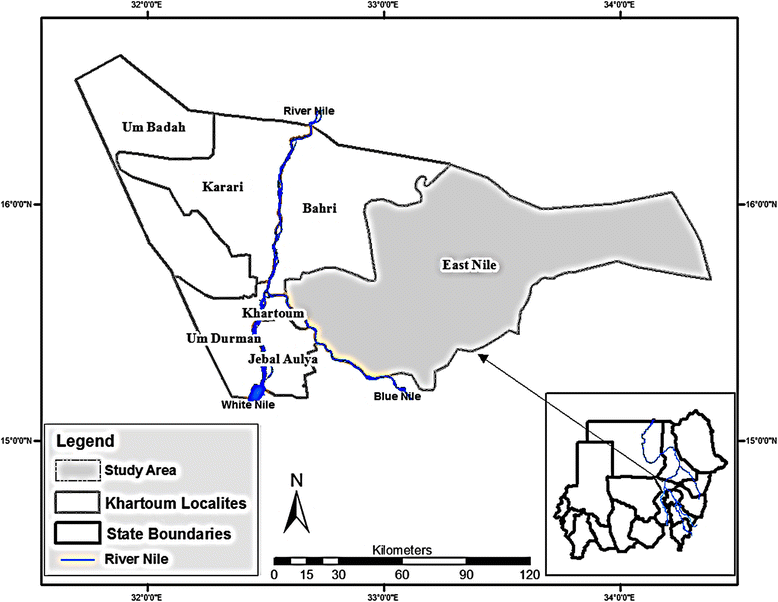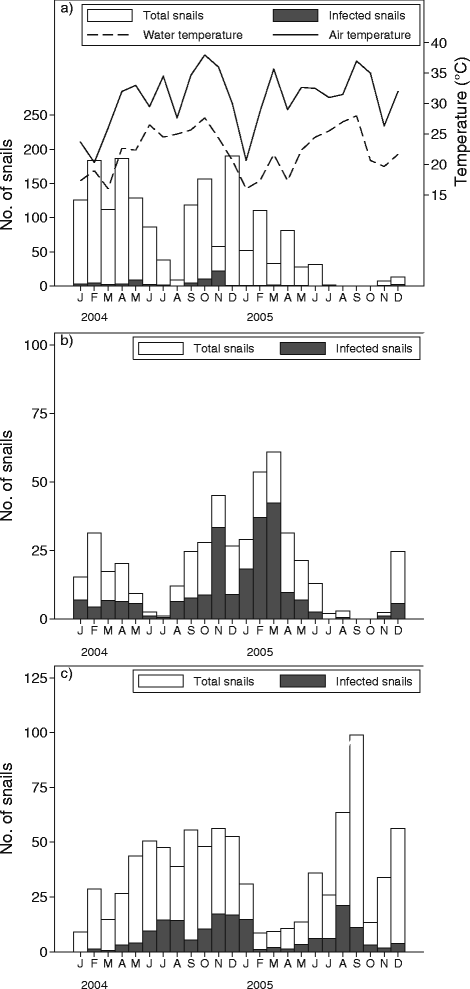Types of trematodes infecting freshwater snails found in irrigation canals in the East Nile locality, Khartoum, Sudan
- PMID: 26915911
- PMCID: PMC4766606
- DOI: 10.1186/s40249-016-0108-y
Types of trematodes infecting freshwater snails found in irrigation canals in the East Nile locality, Khartoum, Sudan
Abstract
Background: The planorbid freshwater snails of the two genera, Biomphalaria and Bulinus -have been vigorously studied due to the role they play as intermediate hosts of schistosomiasis. In Sudan specifically, most studies have focused on the chemical and ecological control of the two genera, but few studies have looked at their biological control. This study explored the coexistence of other species of freshwater snails and the two genera along with their trematode infections in relation to a number of environmental factors in the East Nile locality, Khartoum state, Sudan.
Methods: Freshwater snails from irrigation canals (abueshreens) were sampled monthly from January 2004 to December 2005. The snails were examined for trematode infections by cercarial emergence immediately after collection and then weekly for an additional four weeks to allow for the maturation of prepatent infections. Vegetation cover in the study sites as well as the physicochemical characteristics of the water, including temperature, were also recorded.
Results: A total of 10,493 snails, representing seven species, were collected. The most abundant species was Biomphalaria pfeifferi, representing 48.6 % of the sample. Overall, 14.1 % of the snails were found to be shedding some type of cercariae. Five species were found to have infections; among these the Bulinus truncatus species was found to be the most heavily infected, with an overall prevalence of 46.2 %. Double infections were recorded in only two B. truncatus snails and one Cleopatra bulimoides snail. Twenty different morphotypes of cercariae were recorded, seven of which appeared not to conform to previously described cercariae from Africa. Xiphidiocercariae type 1 was the most common type of cercariae recovered, accounting for 44.3 % of all infections. The density of snails tended to be lower during the summer months than the winter months, except for M. tuberculata snails, which were not affected by seasonal changes.
Conclusion: The findings of this study indicate that besides schistosomes, other larval trematodes are found, and some use the same intermediate hosts as the schistosomes. Further studies should be conducted to determine whether some of these trematodes could be manipulated for the biological control of schistosomiasis.
Figures



Similar articles
-
Environmental determinants of distribution of freshwater snails and trematode infection in the Omo Gibe River Basin, southwest Ethiopia.Infect Dis Poverty. 2019 Nov 20;8(1):93. doi: 10.1186/s40249-019-0604-y. Infect Dis Poverty. 2019. PMID: 31744539 Free PMC article.
-
Distribution of freshwater snails in family-based VAC ponds and associated waterbodies with special reference to intermediate hosts of fish-borne zoonotic trematodes in Nam Dinh Province, Vietnam.Acta Trop. 2010 Oct;116(1):15-23. doi: 10.1016/j.actatropica.2010.04.016. Epub 2010 May 10. Acta Trop. 2010. PMID: 20457118
-
Larval trematode infections in freshwater snails from the highveld and lowveld areas of Zimbabwe.J Helminthol. 2002 Dec;76(4):283-93. doi: 10.1079/JOH2002132. J Helminthol. 2002. PMID: 12498632
-
Freshwater snails as the intermediate host of trematodes in Iran: a systematic review.Epidemiol Health. 2019;41:e2019001. doi: 10.4178/epih.e2019001. Epub 2019 Jan 7. Epidemiol Health. 2019. PMID: 30754962 Free PMC article.
-
An overview of freshwater snails in Asia with main focus on Vietnam.Acta Trop. 2014 Dec;140:105-17. doi: 10.1016/j.actatropica.2014.08.005. Epub 2014 Aug 18. Acta Trop. 2014. PMID: 25149356 Review.
Cited by
-
Loads of trematodes: discovering hidden diversity of paramphistomoids in Kenyan ruminants.Parasitology. 2017 Feb;144(2):131-147. doi: 10.1017/S0031182016001827. Epub 2016 Oct 20. Parasitology. 2017. PMID: 27762185 Free PMC article.
-
Environmental determinants of distribution of freshwater snails and trematode infection in the Omo Gibe River Basin, southwest Ethiopia.Infect Dis Poverty. 2019 Nov 20;8(1):93. doi: 10.1186/s40249-019-0604-y. Infect Dis Poverty. 2019. PMID: 31744539 Free PMC article.
-
Prevalence of Schistosoma mansoni and S. haematobium in Snail Intermediate Hosts in Africa: A Systematic Review and Meta-analysis.J Trop Med. 2020 Sep 7;2020:8850840. doi: 10.1155/2020/8850840. eCollection 2020. J Trop Med. 2020. PMID: 32963554 Free PMC article. Review.
-
Morphological and molecular characterization of invasive Biomphalaria straminea in southern China.Infect Dis Poverty. 2018 Dec 8;7(1):120. doi: 10.1186/s40249-018-0505-5. Infect Dis Poverty. 2018. PMID: 30526682 Free PMC article.
-
Cercarial Fauna of Freshwater Snails in Selected Agricultural Areas in Laguna, Philippines.Helminthologia. 2019 Mar 6;56(1):81-86. doi: 10.2478/helm-2018-0040. eCollection 2019 Mar. Helminthologia. 2019. PMID: 31662677 Free PMC article.
References
-
- Loker ES, Moyo HG, Gardner SL. Trematode- gastropod associations in nine non- lacustrine habitats in Mwanza region of Tanzania. Parasitol. 1981;83:381–399. doi: 10.1017/S0031182000085383. - DOI
-
- AbdElRahman M, AbuGedeiri YB, Ahmed AM, Magzoub M, ElSharief O, Musa S. Prevalence of intestinal schistosomiasis in New Halfa scheme, Eastern Sudan. Khart Med J. 2010;3:448–451.
MeSH terms
LinkOut - more resources
Full Text Sources
Other Literature Sources
Research Materials

